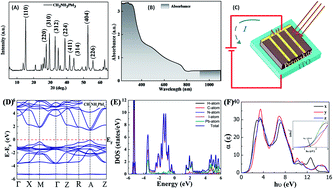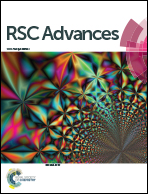Photodynamic response of a solution-processed organolead halide photodetector†
Abstract
CH3NH3PbI3 perovskite semiconductors have received intensive attention as a light absorbing material in high performance solar cells and photodetectors. Herein, we demonstrated a solution-processed photodetector on an indium tin oxide (ITO) substrate by a low-cost spin coating technique. The photodetector exhibits high responsivity, large detectivity and a broad spectrum response. In order to understand the operational mechanism of photodetectors, diode characteristics under dark and at various wavelength lights are performed. The band structure calculation and absorption spectra based on density functional theory (DFT) exhibits a direct band-gap value of 1.53 eV, which is in good agreement with the experimental results. The projected density of states (PDOS) and total density of states (DOS) analysis shows the bonding mechanism in the CH3NH3PbI3. The performance of this perovskite-based photodetector markedly exceeds that of organic and hybrid photodetectors. The accumulation of charge carriers and the hysteresis mechanism was also addressed by a model based on ion migration. Our results provide a proper device design with a simpler approach that has the potential to be scaled up.



 Please wait while we load your content...
Please wait while we load your content...